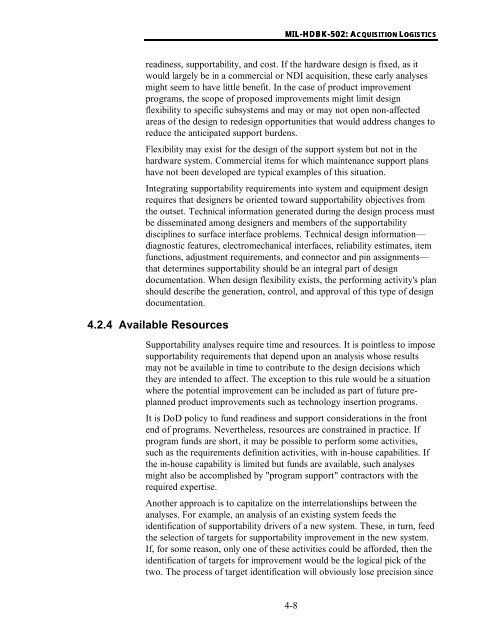MIL-HDBK-502 - Barringer and Associates, Inc.
MIL-HDBK-502 - Barringer and Associates, Inc.
MIL-HDBK-502 - Barringer and Associates, Inc.
Create successful ePaper yourself
Turn your PDF publications into a flip-book with our unique Google optimized e-Paper software.
<strong>MIL</strong>-<strong>HDBK</strong>-<strong>502</strong>: ACQUISITIONALOGISTICSreadiness, supportability, <strong>and</strong> cost. If the hardware design is fixed, as itwould largely be in a commercial or NDI acquisition, these early analysesmight seem to have little benefit. In the case of product improvementprograms, the scope of proposed improvements might limit designflexibility to specific subsystems <strong>and</strong> may or may not open non-affectedareas of the design to redesign opportunities that would address changes toreduce the anticipated support burdens.Flexibility may exist for the design of the support system but not in thehardware system. Commercial items for which maintenance support planshave not been developed are typical examples of this situation.Integrating supportability requirements into system <strong>and</strong> equipment designrequires that designers be oriented toward supportability objectives fromthe outset. Technical information generated during the design process mustbe disseminated among designers <strong>and</strong> members of the supportabilitydisciplines to surface interface problems. Technical design information—diagnostic features, electromechanical interfaces, reliability estimates, itemfunctions, adjustment requirements, <strong>and</strong> connector <strong>and</strong> pin assignments—that determines supportability should be an integral part of designdocumentation. When design flexibility exists, the performing activity's planshould describe the generation, control, <strong>and</strong> approval of this type of designdocumentation.4.2.4 Available ResourcesSupportability analyses require time <strong>and</strong> resources. It is pointless to imposesupportability requirements that depend upon an analysis whose resultsmay not be available in time to contribute to the design decisions whichthey are intended to affect. The exception to this rule would be a situationwhere the potential improvement can be included as part of future preplannedproduct improvements such as technology insertion programs.It is DoD policy to fund readiness <strong>and</strong> support considerations in the frontend of programs. Nevertheless, resources are constrained in practice. Ifprogram funds are short, it may be possible to perform some activities,such as the requirements definition activities, with in-house capabilities. Ifthe in-house capability is limited but funds are available, such analysesmight also be accomplished by "program support" contractors with therequired expertise.Another approach is to capitalize on the interrelationships between theanalyses. For example, an analysis of an existing system feeds theidentification of supportability drivers of a new system. These, in turn, feedthe selection of targets for supportability improvement in the new system.If, for some reason, only one of these activities could be afforded, then theidentification of targets for improvement would be the logical pick of thetwo. The process of target identification will obviously lose precision since4-8
















